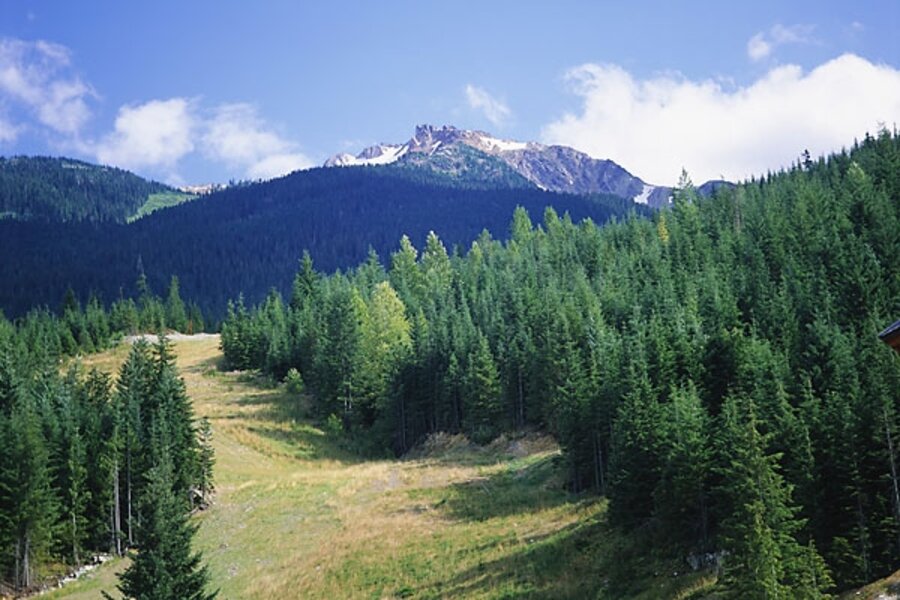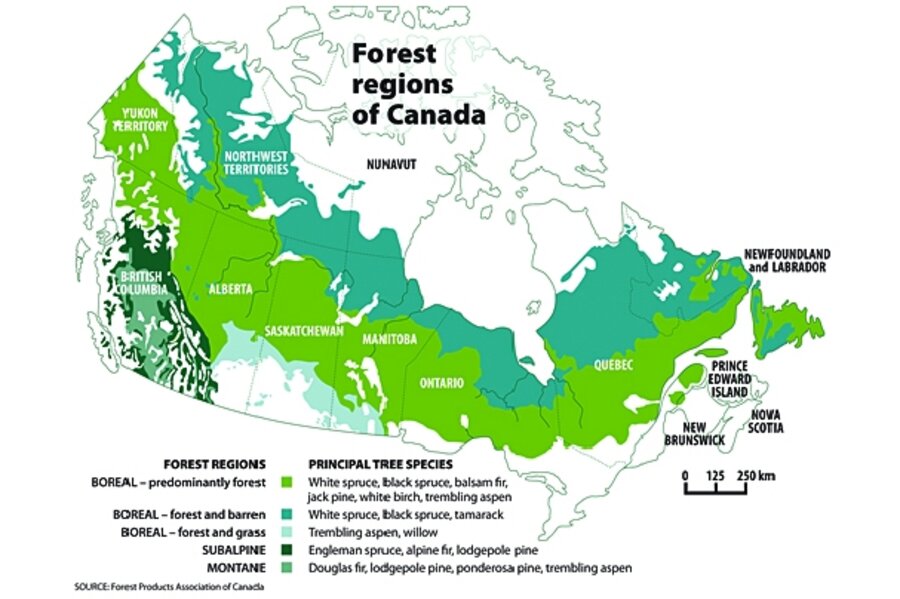Canada’s carbon sink has sprung a leak
Loading...
Billions of tiny mountain pine beetles are treating Canada’s boreal forest like a 3,000-mile-long salad bar, transforming a key absorber of carbon dioxide greenhouse gas into a CO2 emitter instead.
In just a decade, exploding beetle populations and a rise in wildfires have flipped Canada’s boreal forest from its longstanding role as a natural carbon vacuum – sucking up 55 million or more tons of CO2 annually – to that of a giant tailpipe emitting up to 245 million tons of CO2 each year, according to the Canadian Forest Service.
That sharp about-face is raising questions about the future of northern forests worldwide that are being hit hard by global warming – including Russia’s massive boreal expanse, where wildfires have risen dramatically.
The trend has grown clearer in the past decade and was one reason that Canada did not count its forests as a carbon sink as part of the Kyoto climate treaty process: It couldn’t be sure they were.
Debate over how best to respond is growing. Some forest experts argue for more logging to remove vulnerable trees before beetles or fire get to them. Other scientists and environmentalists say the solution lies in logging less and leaving more boreal in its natural state. In 2007, 1,500 highly respected scientists from more than 50 countries called for more protection of Canada’s 1.4 billion-acre boreal forest, calling it one of the largest intact forest and wetland ecosystems left on Earth and home to large populations of grizzly bear, caribou, and wolves.
“The debate is raging on both sides of the argument – and both are using the science for their own purposes,” says Werner Kurz, senior research scientist for the Canadian Forest Service. “Our analysis shows Canada’s boreal has been a sink [CO2 absorber] as recently as the late 1990s, but has now become a source of carbon dioxide.”
Central to the debate is how long trees will be around to absorb and store carbon. Old-growth forests 400 years old or older may store a lot more carbon than a young forest does – but a young forest absorbs it far faster. Since old forests are considered vulnerable to beetles and fires, the question becomes: What’s the right mix of old, slow-growing and young, fast-growing forests?
According to Dr. Kurz’s mathematical model, fires and beetles are projected to destroy a Montana-size swath (144,000 square miles) of boreal by the year 2020, if trends continue. CO2 releases from decaying wood due to the beetle alone are projected at 270 million tons over that period.
While the logging of tropical forests is under scrutiny for hastening global warming, some suggest that more logging of northern boreal makes sense in light of fires and insect devastation.
“If one is truly concerned about the risks to the environment from climate change, then the case can be made that logging of sustainably managed forests should be encouraged,” Ontario Forest Research Institute scientists concluded in a study published last year.
The provincial government study found that carbon may be stored longer in wood products like construction lumber (which has a half-life of 67 to 100 years) than as forest. Using wood in construction also reduces carbon emissions if it replaces steel or concrete. The report concluded that more, not less, timber harvesting is called for in the beetle- and fire-prone boreal.
“Nonsense,” says Merran Smith, the Vancouver-based director of climate programs for ForestEthics, an international environmental group.
Cutting more trees is “robbing the carbon bank.” Despite its shift from carbon sink to carbon source, Canada’s boreal forest remains today a repository to an estimated 186 billion tons of carbon, the equivalent of 27 years of global carbon emissions.
Peat bogs may be ‘carbon bomb’
“Such studies [as the Ontario Forest Research Institute’s] fit conveniently with the timber industry’s conclusion that these forests should be logged,” Ms. Smith says. “The idea that you’re going to reduce global warming by logging more is ridiculous. These forests are storing an enormous amount of carbon.”
How enormous? Perhaps the most overlooked piece of the puzzle may be that cutting forest canopy could release massive amounts of CO2 contained in yards-thick peat bogs that lie beneath the boreal. That peat layer is not only a “carbon bank,” but potentially a “carbon bomb,” some say.
David Schindler, professor of ecology at the University of Alberta, is among a number of scientists worried that cutting the forest faster could vastly accelerate global warming by causing the peat layer to dry out, decay, and release CO2 – or to burn in wildfires.
“A lot of people are fooled because the trees don’t seem very large,” Professor Schindler says. “They don’t realize there’s as much carbon stored in the forest floor as in the Amazon. That ‘carbon bomb,’ as some call it, is a real concern.”
The Canadian forest industry in 2007 responded to increased beetle- and fire-killed timber by increasing harvest rates, the CFS reported last year. Given that much of the boreal may live less than a century, the Ontario Forest Research Institute found “sustainable forest management and use of wood products helps to mitigate climate change.”
“Sustainable” is open to debate.
Some 70 percent of the nation’s managed forest – and much of the boreal – is certified by third parties as “sustainably managed,” the Forest Products Association of Canada reports. All land managed by FPAC members is certified sustainable and the group touts its investments in energy efficiency.
That doesn’t impress Peter Lee of Global Forest Watch Canada.
“It’s clear to me that the managed part of the forest is contributing to the forest turning into a carbon source,” Mr. Lee says. “The more heavily you manage for logging and industrial activity, the more these forests become a source of atmospheric carbon.”
But as long as global demand exists for wood products, “very few sources are as carefully managed as ours,” counters Avrim Lazar, president of FPAC. “The real question is: If you didn’t get [wood] from the [Canadian] boreal, where would it come from?’ ”
One answer: from illegal logging activities in Russia’s hard-pressed boreal forest – which contains half the world’s boreal, he says. FPAC, he points out, supported the Ontario government’s move last year to put 55 million acres, about one-quarter of the provincial forest, off limits to logging.
In the end, what is truly sustainable may hinge on a hotly debated issue: How much carbon is stored – and for how long – in wood products like homes, furniture, and paper? Wood framing for homes can prevent release of carbon into the atmosphere for as long or perhaps longer than forests themselves, the study says.
Product disposal is critical factor
“If the stuff ends up in landfill, then it comes back as methane which destroys us completely on the cycle,” Mr. Lazar says. Airless landfills promote the production of methane as a byproduct of decomposition. As a greenhouse gas, methane is ten times as potent as carbon dioxide.
“Really, the critical factor on whether forestry has a positive or negative impact on greenhouse gases is management of the product at the end of the life cycle.”
But with much of Canada’s logging going to produce paper, the carbon content of which is released back into the air in just a few years, environmentalists say more detailed life cycle analyses of wood-product carbon is required. Researchers are looking into such things as the impact longer logging roads would have on emissions from logging trucks driving further.
Such issues may inevitably become part of the debate at the coming climate summit in Copenhagen this December. But Andrew Park, an assistant professor at the Center for Forest Interdisciplinary Research at the University of Winnipeg, is circumspect about the impact of less or more logging on greenhouse-gas emissions.
“Our vast territory and the variability in disturbance ... means that we will never be able to control whether the boreal forest as a whole acts as a source or a sink,” he writes in an e-mail.
To ensure that the boreal forest continues to act as a globally important carbon sink, he writes, “we need to limit the warming that is underway. Not to do so is to risk losing the billions of tons of carbon stored in peat and permafrost.”






